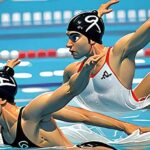The Intricacies of Wheelchair Tennis: A Unique Combination of Tennis and F1
Wheelchair Tennis is poised to be a compelling and captivating discipline at the forthcoming Paris 2024 Paralympic Games. The esteemed French athlete, Stéphane Houdet, will be demonstrating his prowess at the Roland-Garros Stadium, and he generously took the time to illuminate the distinctive characteristics of his sport.
The courts of Roland-Garros will be the venue for six Wheelchair Tennis tournaments during the Paralympic Games. Stéphane Houdet, a five-time Paralympic medalist, is anticipated to be a strong contender for the podium at this esteemed event. Just days before the commencement, Houdet shared his insights into the unique features of Wheelchair Tennis.
In a recent interview with Olympics.com, Houdet expounded on the most significant difference between Wheelchair Tennis and the traditional form of the sport, which is the rule permitting the ball to bounce twice before a shot is made. Despite the initial prevalence of extended exchanges on the second bounce in the early days of the sport, statistics from various Grand Slam tournaments indicate that the ball is now played on the first bounce in 9 out of 10 instances. Houdet stressed that the second bounce is primarily employed for strategic drop shots or smashes.
Houdet also underscored the distinctive nature of Wheelchair Tennis, likening it to a fusion of tennis and Formula 1. He highlighted that apart from the advanced evolution of the wheelchairs used in the sport, the trajectory dynamics in Wheelchair Tennis bear similarities with motorsports or skiing. The necessity of maintaining wheelchair speed when in motion was another unique feature mentioned by Houdet, who emphasized that the shortest path is not necessarily the fastest when in a wheelchair.
The difficulties of maintaining visual contact with the ball when the player’s back is turned to the net, particularly on different playing surfaces, were also outlined by Houdet. He observed that on grass and clay courts, it is more challenging to defend due to the heightened rolling friction, making it more conducive for attackers. Additionally, the physical demands of the sport are intensified as players need to make multiple movements to compensate for the friction between the wheelchair and the court.
Interestingly, Houdet elaborated on the rule requiring at least one buttock to be in contact with the chair when the player hits the ball, underscoring the necessity of being unified with the chair. While discussing the absence of standing tennis at the Paris 2024 Paralympic Games, Houdet expressed his optimism regarding the potential for Wheelchair Tennis to become a universally inclusive sport, bridging the gap between different abilities.
Stéphane Houdet’s comprehensive elucidation sheds light on the intricacies and unique aspects of Wheelchair Tennis, providing a deeper insight into the sport as it prepares for a momentous showcase at the Paris 2024 Paralympic Games.








Post Comment